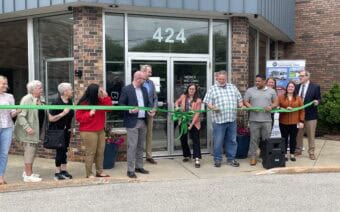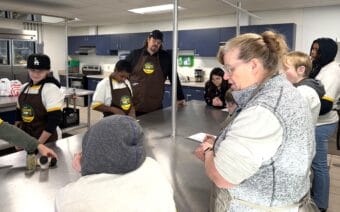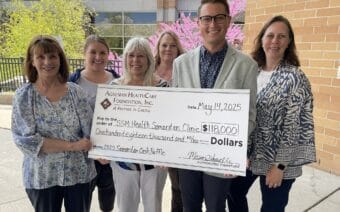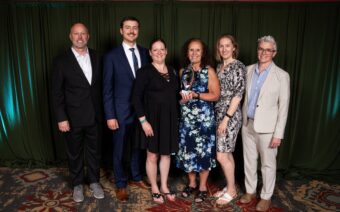
December 13, 2023
GREEN BAY – Recovering from a lower extremity injury or surgery can be challenging.
Patients look to build strength but are limited by how much weight they can put on their hips, knees, ankles and feet.
Adam Wied, a physical therapist at the Prevea East De Pere Health Center, said the AlterG Anti-gravity Treadmills – which are available at two area Prevea clinics – aim to help change that.
“For many patients post-op, they may not be able to walk without assisted devices, but the treadmill allows them to move and keep their muscles active while also strengthening them,” he said. “The AlterG treadmill facilitates targeted rehabilitation by allowing users to gradually increase their weight-bearing capacity, improving strength and mobility over time.”
To use the equipment, Wied said patients wear special shorts and are zipped into an air chamber on the treadmill.
When turned on, he said the chamber surrounds the body’s lower extremities in a cocoon of air, supporting the patient’s body and reducing the amount of weight felt.
Prevea Health patient Melissa Loncore used the anti-gravity treadmill following a total hip replacement and said it made her recovery faster and easier.
“I was amazed,” she said. “The hip replacement was my fourth joint replacement, plus one joint revision, in three and a half years. I was still experiencing residual discomfort and range of motion issues from the previous surgeries that were hampering my recovery from the most recent surgery. The use of the treadmill allowed me to do the exercises without the discomfort in my knees hampering me.”

Adam Wied, a physical therapist with Prevea Health, said the treadmill helps patients get back to their regular activities and lives more quickly. Submitted Photo
Loncore said using the treadmill seemed to be a “turning point for me” to be able to progress toward a return to a normal activity level before all the surgeries.
Equipment details
Inspired by NASA technology, Wied said the AlterG Anti-Gravity Treadmill is used by Olympic teams, professional sports teams and top university-affiliated rehabilitation and sports centers.
The treadmills, he said, use positive air pressure to provide partial body-weight support thereby lowering impact forces and metabolic demand of walking or running.
Wied said the equipment allows patients to feel anywhere from 20% to 100% of their body weight.
For example, he said, a 150-pound person at a 20% antigravity rate would only weigh 30 pounds in the chamber.
“As therapy continues, we gradually increase the amount of weight patients feel until we get to 100%,” he said. “The different air pressures allow users to exercise with less strain on their bodies. This innovative technology also enables athletes to maintain their training routines while minimizing the risk of further injury.”
Wied said the treadmill is ideal for patients with hip, ankle, foot and knee injuries or who are recovering from surgery.
“The treadmill is cutting-edge technology,” he said. “I cannot think of a patient who wouldn’t benefit from using this as part of their recovery process.”
Loncore said the treadmill’s display provides immediate feedback on the length of strides and how much weight you are putting on each leg as you step.
“I could see when anything was off and could correct it,” she said. “Without that, it’s difficult to self-monitor how evenly you are moving.”
Loncore said using the treadmill feels like you are walking through water.

The treadmill’s display provides immediate feedback on the length of strides and shows patients how much weight they are putting on each leg as they step. Submitted Photo
Wied said there’s some resistance and pressure but no jarring sensation to the joints.
Though physical therapists have found great success from the treadmill for patients recovering from a lower-body injury or surgery, Wied said it can also be helpful for patients with neurological conditions, chronic disease, balance issues, obesity and orthopedic disorders.
“The treadmill helps patients get back to their regular activities and lives more quickly,” he said.
Wied said patients experience less pain since they are not putting their full body weight on the injured body part.
“(Prevea physical therapists) have a great relationship with our providers, and we work together to produce the best outcome for patients, including getting them up and moving,” he said. “The treadmill allows patients to walk longer than they could without it.”
Available locally
Prevea has anti-gravity treadmills at its Ashwaubenon (2502 S. Ashland Ave.) and East De Pere (3860 Monroe Road) clinics.
The East De Pere clinic added the equipment in August, while Ashwaubenon received its last spring.
The anti-gravity treadmill may be used as part of the physical therapy treatment plan and is also available as a cash-pay option for $10 for every 15 minutes of use.
More information can be found at prevea.com.
 Four recognized as 2023 Aurora Health Care Nurses of the Year
Four recognized as 2023 Aurora Health Care Nurses of the Year Ardy & Ed’s Drive In serving up food and fun since 1948
Ardy & Ed’s Drive In serving up food and fun since 1948








